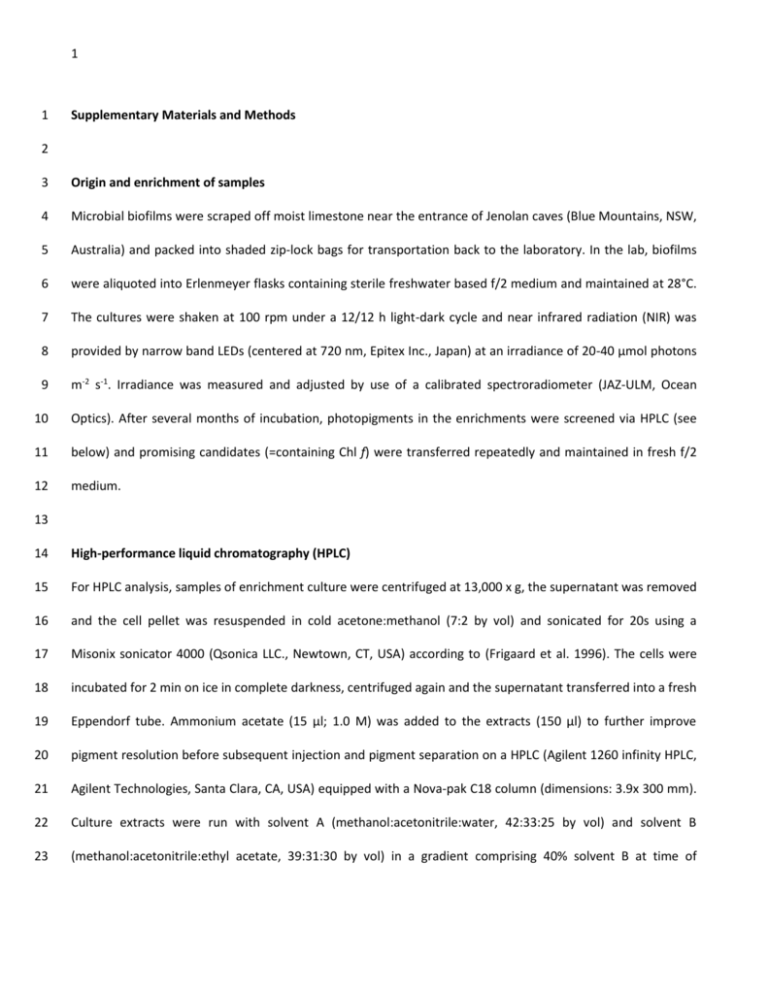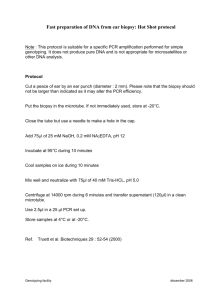Supplementary Information (doc 63K)
advertisement

1 1 Supplementary Materials and Methods 2 3 Origin and enrichment of samples 4 Microbial biofilms were scraped off moist limestone near the entrance of Jenolan caves (Blue Mountains, NSW, 5 Australia) and packed into shaded zip-lock bags for transportation back to the laboratory. In the lab, biofilms 6 were aliquoted into Erlenmeyer flasks containing sterile freshwater based f/2 medium and maintained at 28°C. 7 The cultures were shaken at 100 rpm under a 12/12 h light-dark cycle and near infrared radiation (NIR) was 8 provided by narrow band LEDs (centered at 720 nm, Epitex Inc., Japan) at an irradiance of 20-40 µmol photons 9 m-2 s-1. Irradiance was measured and adjusted by use of a calibrated spectroradiometer (JAZ-ULM, Ocean 10 Optics). After several months of incubation, photopigments in the enrichments were screened via HPLC (see 11 below) and promising candidates (=containing Chl f) were transferred repeatedly and maintained in fresh f/2 12 medium. 13 14 High-performance liquid chromatography (HPLC) 15 For HPLC analysis, samples of enrichment culture were centrifuged at 13,000 x g, the supernatant was removed 16 and the cell pellet was resuspended in cold acetone:methanol (7:2 by vol) and sonicated for 20s using a 17 Misonix sonicator 4000 (Qsonica LLC., Newtown, CT, USA) according to (Frigaard et al. 1996). The cells were 18 incubated for 2 min on ice in complete darkness, centrifuged again and the supernatant transferred into a fresh 19 Eppendorf tube. Ammonium acetate (15 µl; 1.0 M) was added to the extracts (150 µl) to further improve 20 pigment resolution before subsequent injection and pigment separation on a HPLC (Agilent 1260 infinity HPLC, 21 Agilent Technologies, Santa Clara, CA, USA) equipped with a Nova-pak C18 column (dimensions: 3.9x 300 mm). 22 Culture extracts were run with solvent A (methanol:acetonitrile:water, 42:33:25 by vol) and solvent B 23 (methanol:acetonitrile:ethyl acetate, 39:31:30 by vol) in a gradient comprising 40% solvent B at time of 2 24 injection, a linear increase to 100% B at 60 min and back to 40% B in 3 minutes. The flow rate was kept 25 constant at 1 ml min-1 and the column was kept at a temperature of 30°C. A spectral detector (1260 Infinity 26 Multiple Wavelength Detector, Agilent Technologies, Santa Clara, CA, USA) was used for the detection of 27 compound-specific absorption characteristics at wavelengths between 190-950 nm. Photopigments were 28 identified manually by carefully detecting absorption from the resulting HPLC chromatograms as stated in 29 (Frigaard et al. 1996). 30 31 Hyperspectral imaging 32 Enrichment culture samples were mounted on microscopy slides under a coverslip and were screened for the 33 occurrence of Chl f with a hyperspectral image scan unit (100T-VNIR, Themis Vision, Bay Saint Louis, MS, USA) 34 mounted on a compound microscope (Axioscope FS, Zeiss, Germany) using the built-in halogen lamp for 35 illumination. Hyperspectral image stacks were corrected (in Hypervisual 3.0, Themis Vision) for background 36 noise under darkness and normalized to percent (%) transmission using hyperspectral image stacks recorded in 37 regions without cells as 100% transmission (Kühl and Polerecky 2008). Reflectance spectra averaged over 38 particular areas of interest (AOI) were subsequently calculated and extracted from the hyperspectral image 39 stack by the system software. 40 41 Microsensor measurements 42 Clusters of cells were removed from Chl f enrichment cultures and placed onto solidified 1% low-melting point 43 agarose in a deep-well microscopy slide. Cells were then overlaid with a thin layer of agarose and placed into 44 darkness for solidification. A petri dish filled with pre-warmed f/2 medium was aerated using an aquarium 45 pump and the cell-containing microscopy slide placed within. A Clark-type O2 microsensor (tip size ~20 µm; 46 Revsbech 1989) was mounted on a motorized micromanipulator (Pyro-Science GmbH, Aachen, Germany) and 3 47 connected to a picoammeter (Unisense PA2000, Unisense A/S, Aarhus, Denmark). The sensor was linearly 48 calibrated from measurements in O2-free medium (by the addition of sodium dithionite) and fully aerated 49 medium at experimental temperature and salinity. The position where the microsensor tip touched the cell 50 cluster was determined by visual inspection using a stereo microscope mounted on a stand. All microsensor 51 signals were recorded on a strip-chart recorder (Kipp and Zonen, B.V., Delft, Netherlands) and via an A/D 52 converter (AD-216, Unisense A/S, Aarhus, Denmark) and gross-photosynthesis (in units of nmol O2 cm-3 s-1) was 53 quantified using the O2 microsensor light-dark shift method (Kühl et al. 1996; Revsbech et al. 1983). 54 55 Transmission electron microscopy 56 Samples were fixed with 2% v/v glutaraldehyde in 0.05 M sodium phosphate buffer (pH 7.4) for 24 h. Samples 57 were then rinsed three times in 0.15 M sodium cacodylate buffer (pH 7.4) and subsequently postfixed in 1% 58 w/v OsO4 in 0.12 M sodium cacodylate buffer (pH 7.4) for 2 h. The specimens were dehydrated in graded series 59 of ethanol, transferred to propylene oxide and embedded in Epon according to standard procedures. Sections, 60 approximately 80 nm thick, were cut with a Reichert-Jung Ultracut E microtome and collected on copper grids 61 with Formvar supporting membranes. Sections were stained with uranyl acetate and lead citrate and were 62 examined with a Philips CM 100 TEM (Philips, Eindhoven, The Netherlands), operated at an accelerating 63 voltage of 80 kV. Digital images were recorded with an OSIS Veleta digital slow scan 2k x 2k CCD camera and 64 the ITEM software package. 65 66 Molecular analysis 67 DNA from an enrichment culture was extracted with the FastDNA for soil kit (MP Biomedicals, France) using the 68 manufacturers standard protocol. DNA concentration was quantified using a Qubit system (Invitrogen, Life 69 Technologies Europe, USA), adjusted to 5 ng µl-1 using water and stored at -20°C until further use. From the 4 70 DNA, the V4 region of the 16S rDNA gene was amplified using the modified primers 515F 71 (GTGCCAGCMGCCGCGGTAA) and 806R (GGACTACNNGGGTATCTAAT). The PCR mix (20 µl) contained: 2.0 µl 72 of 10X AccuPrime PCR Buffer II containing 15 mM MgCl2, 0.12 µl AccuPrime Taq DNA Polymerase (2 U µl-1, Life 73 Technologies, Carlsbad, CA, USA), 1.0 µl of each primer (10 µM), 2 µl DNA template and water to a total of 20 74 µl. The first PCR mix was incubated according to following conditions: initial activation of the “hot start” 75 polymerase at 94°C for 2 min, followed by 30 cycles of 94°C for 20 s, 56°C for 20s and 68°C for 30s, and final 76 extension at 68°C for 5 min. The amplified PCR product was incubated at 70°C for 3 min then placed on ice to 77 minimize hybridization between specific PCR products and short non-specific amplicons. The concentration of 78 amplified DNA was measured by Pico Green (Life Technologies) and LightCycler 96 (Roche, Basel, Switzerland). 79 Addition of adapters and Index to DNA fragments was done in a second PCR containing: 2.0 µl 10X AccuPrime 80 PCR Buffer containing 15 mM MgCl2, 0.12 µl AccuPrime Taq DNA Polymerase (2 U µl-1, Life Technologies), 1.0 µl 81 of each barcoded fusion primers (10 µM), 2 µl of 10X diluted PCR product from first PCR and water to a total of 82 20 µl. The PCR incubation conditions for second PCR were: an initial activation of the “hot start” polymerase at 83 94°C for 2 min, followed by 15 cycles of 94°C for 20 s, 56°C for 20s and 68°C for 30s, and final extension at 68°C 84 for 5 min. The amplified PCR product was incubated at 70°C for 3 minutes and then directly placed on ice. The 85 amplified PCR product was purified by Agencourt AMPure XP (Beckman Coulter, Pasadena, CA, USA). The 86 concentration of amplified DNA was measured by Pico Green (Life Technologies) on a LightCycler 96 (Roche) 87 and hereafter concentrated with the DNA Clean and Concentrator-5 kit (Zymo Research, Irvine, CA, USA). 88 Sequencing of the 16S rDNA gene was done using MiSeq reagent kit v2 (500cycles) and a MiSeq sequencer 89 (Illumina inc., San Diego, CA, USA). All unprocessed sequences were deposited ar EMBL under the accession 90 number PRJEB7980. Miseq reads were classified using the Illumina 16S Metagenomics Basespace app. and 91 reads classified down to the order Synechococcales (=the only oxygenic phototrophs present) were extracted 92 from the fastq files (=6.210 reads of a total of 57.627 reads). The UPARSE pipeline (Edgar 2013) was used to 5 93 cluster the reads into a single OTU at 97%. Briefly, paired end reads were merged with usearch using the 94 options fastq_truncqual 3 and fastq_maxdiffs 2, for quality control. Merged reads were dereplicated and 95 sorted with usearch. Reads were clustered with usearch -cluster_otu, discarding singletons as recommended. 96 The resulting representative sequence (GTGCCAGCAGCCGCGGTAAGACGGAGGAGGCAAGCGTTATCCGGAATTATT 97 GGGCGTAAAGCGTCCGCAGGTGGCTTCTCAAGTCTGCTGTCAAAGCCCAGGGCTCAACCCTGGATAGGCAGTGGAAACTGGGTCGCTA 98 GAGTACGGTAGGGGTAGAGGGAATTCCCGGTGTAGCGGTGAAATGCGTAGATATCGGGAAGAACACCAGTGGCGAAGGCGCTCTAC 99 TGGACCGTAACTGACACTCATGGACGAAAGCTAGGGGAGCGAAAGGGATTAGAAACCCCAGTAGTCC) was used for tree 100 building with reference sequences downloaded from SILVA (http://www.arb-silva.de/). Reference sequences 101 and the representative sequence were aligned using MUSCLE (Edgar 2004) as implemented in SeaView (Gouy 102 et al. 2010). Maximum-likelihood phylogenetic tree reconstruction was done in MEGA6 (Tamura et al. 2013) 103 using the implemented GTR (I + G) model with five discrete gamma categories. Branch support was estimated 104 by performing 100 bootstrap replications (Felsenstein 1985). 105 106 107 108 109 110 111 112 113 114 115 6 116 Supplementary references 117 118 Edgar RC. (2004). MUSCLE: multiple sequence alignment with high accuracy and high throughput. Nucleic Acids Res. 32:1792–7. 119 120 Edgar RC. (2013). UPARSE: highly accurate OTU sequences from microbial amplicon reads. Nat. Methods 10:996–8. 121 122 Felsenstein J. (1985). Confidence limits on phylogenies: an approach using the bootstrap. Evolution (N. Y). 39:783–791. 123 124 Frigaard N, Larsen KL, Cox RP. (1996). Spectrochromatography of photosynthetic pigments as a fingerprinting technique for microbial phototrophs. FEMS Micriobiology Ecol. 20:69–77. 125 126 Gouy M, Guindon S, Gascuel O. (2010). SeaView version 4: A multiplatform graphical user interface for sequence alignment and phylogenetic tree building. Mol. Biol. Evol. 27:221–4. 127 128 Kühl M, Glud RN, Ploug H, Ramsing NB. (1996). Microenvironmental Control of Photosynthesis and Photosynthesis -coupled respiration in an epilithic cyanobacterial biofilm. J. Phycol. 32:799–812. 129 Revsbech N. (1989). An oxygen microsensor with a guard cathode. Limnol. Oceanogr. 34:474–478. 130 131 Revsbech N, Jorgensen B, Blackburn T, Cohen Y. (1983). Microelectrode studies of the photosynthesis and 0 2, H2S, and pH profiles of a microbial mat. Limnol. Ocean. 28:1062–1074. 132 133 Tamura K, Stecher G, Peterson D. (2013). MEGA6: molecular evolutionary genetics analysis version 6.0. Mol. Biol. Evol. 1–12. 134 135 136 137 138 139 7 140 Supplementary Figure legends: 141 Figure S1: HPLC chromatograms and spectral characteristics of eluents from cells enriched under NIR. (A) 142 Samples contained detectable amounts of Chl f (at ~44.5 min) and Chl a (~49 min) absorbing maximally at 704- 143 708 and 665 nm, respectively. (B) Absorption spectrum of HPLC-extracted Chl f (in acetone:MeOH) with 144 maximum absorption occurring at 404 and 704 nm. 145 146 Figure S2: Order level taxonomy of enrichment cultures containing Chl f. Results were generated using Illumina 147 16S rDNA gene amplicon sequencing on the MiSeq system. Data were analyzed as stated in the materials and 148 methods section and here displayed are the 57,627 reads classified to the order level. Reads belonging to the 149 Synechococcales, the only order in the sample known to contain oxygenic phototrophs, were extracted (=6,210 150 reads) and clustered, resulting in a single OTU. The latter OTU was hereafter used to construct a Neighbor- 151 joining tree. 152 153








